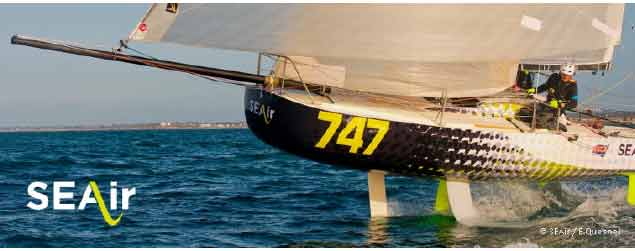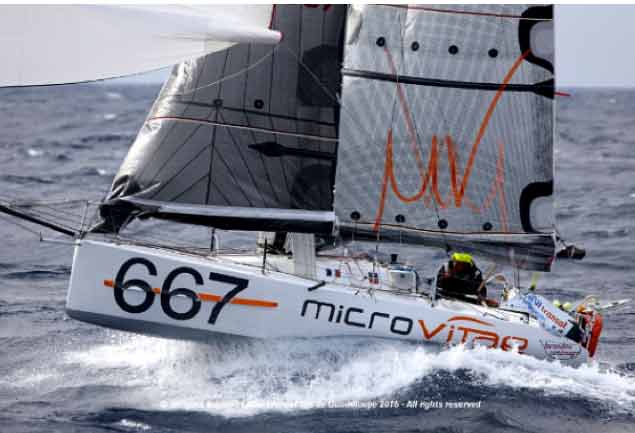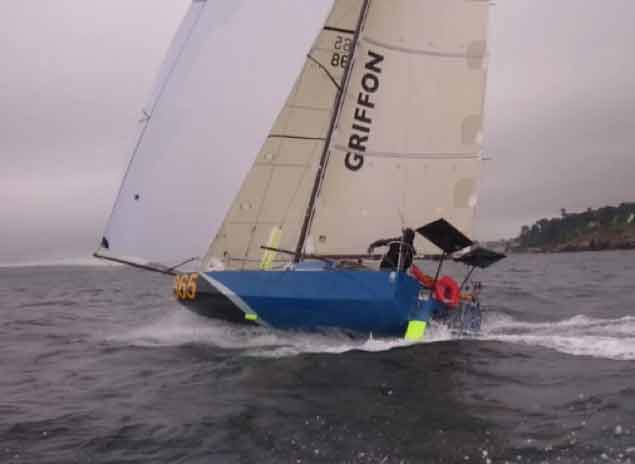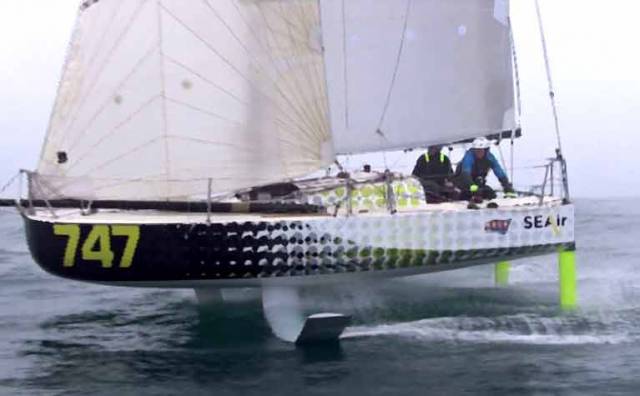2016 might well have been the year of the foil in offshore sailing writes solo sailor Thomas Dolan. Here the sole Irish 'Mini Classe' competitor assesses some of the latest developments from his base in France and asks will a 'foiler' win the Mini–Transat this year?
Armel Le Cleach decimated the record of the Transat Bakerly and then the Vendee Globe and silenced once and for all the argument about foils in the Open 60 Classe. Even though it will be interesting to know exactly how much of the time the leaders actually used them in the deep south, it is certain that they were a key factor in the descent of the Atlantic Ocean which allowed the lead group to propel themselves into a weather system ahead of the rest never to be caught.
But some may forget or simply not know, that when Banque Populaire first began to research and develop it’s foils, they turned to the laboratories of offshore sailing. Where many have turned for almost 40 years, where we have perfected canting keels, elongating keels, swinging masts and swinging rudders in the Mini Transat 650.
 Armel le cleach on board the Mini 198 in 2015
Armel le cleach on board the Mini 198 in 2015
In 2015 the Classe Mini formally allowed appendices on prototype boats to extend outside the 3m box rule once the starting gun had fired. The aim was to ensure that there would be a number of foiling mini’s on the start line this year. There has been a lot of progress made, and numerous skippers planned or will be planning something either for this edition or the next. Here’s a little run down of whats been going on in an effort to try and answer the big question of will a foiler win the mini transat in 2017!
 Arkema The 900 - as well as foils, this prototype also has a self-supporting (no shrouds) wing mast
Arkema The 900 - as well as foils, this prototype also has a self-supporting (no shrouds) wing mast
Arkema: The 900 is packed full of innovations, it’s largest one is probably not even the tilting foils with which it is equipped but the fact that it is built of what the chemical company claim to be a recyclable resin, which some day may allow boats to be properly recycled at the end of their life. Other innovations include a self-supporting (no shrouds) wing mast, a bow sprit that retracts into the boat and can be orientated with a pivoting forestay and then of course there are the foils. The system to orientate each foil is not new, the team took the same system that has been used for many years on canting keels, allowing the foils to be adjusted, trimmed and retracted into the boat when need be. These innovations are impressive but they have left the boat with a handicap, its weight. The 900 comes in at a little over one ton, which is a lot for a prototype, almost 300 kilos more than some of the lighter boats. Word is that in a flat sea the boat does lift a little on its foil but it is yet to be known if in a heavy sea it will be able to keep up the average speeds needed to win the mini. Will it hop up and down on the swell? Foiling briefly then nose diving into a wave? Will the autopilot be able to perform? After all in single–handed offshore racing it’s an averages game.
 747 Sea Air - the first flying Mini Classe boat
747 Sea Air - the first flying Mini Classe boat
747: The Flying Mini. Whereas Arkema never said the aim was to fly, from the get–go their interest in the foil was to increase the righting moment and therefore the power of the boat while allowing it to lift and plane sooner. The aim of SeaAIR and the 747 has been to make a flying mini, and they have succeeded. The foil they use is much larger and a lot closer to what is known as a DSS (dynamic stability system) basically a wing with no tip that extends out from the side of the boat. The team are very much in the Research and Development stage of the project but the results are impressive, after just four outings they have flown each time. In as little as 8 knots of true wind speed the boat has lifted out of the water. When not in use the foils are stored by sliding them up to deck level, just like traditional dagger boars. The problem this brings is that the added weight up high means that the righting moment of the boat may not be enough to meet the classe mini’s specifications. This can perhaps be rectified by adding weight to the keel, but do they want to? Another impractical problem is due to the space occupied by the foils when in ‘up’ position is that the head sail cannot be sheeted in, so going to windward could prove complicated without reducing sail area. But it is the first one that actually flies!
 Mini classe 888 - commonly know as the 'Grenouille' or 'the frog'
Mini classe 888 - commonly know as the 'Grenouille' or 'the frog'
888: In 2015, before the rule change there actually already was a foiling mini. Simon Koster who finished an impressive 2nd place in the production class in 2013 set out in what became Mini classe 888 - commonly know as the 'Grenouille' or 'the frog'. While waiting for the rule change, the boat was initially fitted out with inward facing foils. Despite short bursts at up to 22 knots of boat speed, the foils proved to be unimpressive overall and ended up being quite a handicap while sailing upwind. Definitely a boat built for speed rather than beauty, In 2017 it is quite possible that we see her with a real set of foils which could make it a serious contender.
93?? : Word on the pontoons is that there is a brand new foiler being speed-built in Tunisia, by well known German Skipper Jorg Reichers. Construction started in the new year and the plan is to have the boat in the water for May. The team will have a big job ahead of them to have the boat ready and qualified for the Transat, more news will be coming soon.
 Mini class 667 - Eva Lune, twice winner and to this day still the most decorated
Mini class 667 - Eva Lune, twice winner and to this day still the most decorated
One great thing about the introduction of foils in the classe is that it could mean the regeneration of some of the older boats in the circuit. Modern designs have let to boats becoming wider and more powerful as architects push chines further and further foreward. The scow shaped bows have impressively dominated the classe since David Raison won in 2011 on the original 747. Especially when reaching, from anything between 80 and 130 degrees to the true wind the older, narrower boats have struggled. There are many of these older boats still in the circuit, some of them very well built and very light and with a lot of history. Boats such as the 667 Eva Lune, twice winner and to this day still the most decorated in the class. There is also the 754 which still holds the record for the most miles covered in 24 hours (294 Miles). The increased righting moment of a pair of foils could be just what the doctor ordered to give them a new lease of life.
This idea of sustainability is something that is becoming more and more important within the classe. This year there are several protoypes who will be competing with only solar power, greatly aided by the massive advancements in the quality of solar panels. The plan for 2019 is to allow lithium batteries in production boats on the condition that they rely only on renewable energy. The long term goal is that the Mini Transat become the first ocean race completely free of fossil fuels.
So will a foiler win the Mini? For 2017 I remain sceptic, primarily because there are so few of them and those that will be on the start line will not have many miles under the keel. To succeed in the Mini 650 Circuit what is needed is polyvalence. To be good all round. It is an averages game. For the second part of the transat, being fast on downwind VMG is of course a great benefit, especially if the trade winds are nicely in place. The advantage of foils comes into play when reaching, when the boat is pushing onto the foil. The foilers will most certainly be dominant around 110/120 TWA, even more so in strong winds, but what about all the rest? And what about the VMG? Making the foils lift will mean a higher VMG, possibly as high as 130 and this increases the tactical risk, being the wrong side of shift will hurt a hell of a lot more!
At the end of the day the biggest question is will it be enough to get ahead of Ian Lipinski and his 865 'Griffon.fr'? This will be his third transat, flipped upside down and forced to abandon his boat in 2013, winner in the production classe in 2015 and winner of every race in 2016 for now he the favourite sticker remains solidly in place. Victory would make him the first person to win the race in both production and protoype classe, and for now I wouldn’t bet against him!
 Ian Lipinski and his 865 “Griffon.fr – a favourite this season
Ian Lipinski and his 865 “Griffon.fr – a favourite this season
Tom Dolan departs this Saturday in his production (non foiling) Mini in the first race of the season































































